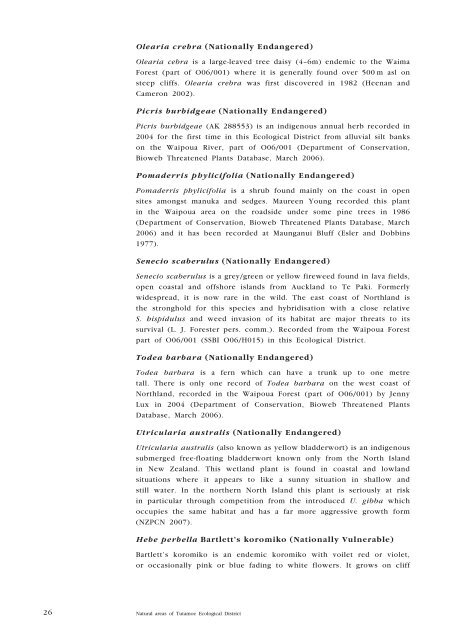Natural areas of Tutamoe Ecological District (3. Ecological character)
Natural areas of Tutamoe Ecological District (3. Ecological character)
Natural areas of Tutamoe Ecological District (3. Ecological character)
Create successful ePaper yourself
Turn your PDF publications into a flip-book with our unique Google optimized e-Paper software.
Olearia crebra (Nationally Endangered)<br />
Olearia cebra is a large-leaved tree daisy (4–6m) endemic to the Waima<br />
Forest (part <strong>of</strong> O06/001) where it is generally found over 500 m asl on<br />
steep cliffs. Olearia crebra was first discovered in 1982 (Heenan and<br />
Cameron 2002).<br />
Picris burbidgeae (Nationally Endangered)<br />
Picris burbidgeae (AK 288553) is an indigenous annual herb recorded in<br />
2004 for the first time in this <strong>Ecological</strong> <strong>District</strong> from alluvial silt banks<br />
on the Waipoua River, part <strong>of</strong> O06/001 (Department <strong>of</strong> Conservation,<br />
Bioweb Threatened Plants Database, March 2006).<br />
Pomaderris phylicifolia (Nationally Endangered)<br />
Pomaderris phylicifolia is a shrub found mainly on the coast in open<br />
sites amongst manuka and sedges. Maureen young recorded this plant<br />
in the Waipoua area on the roadside under some pine trees in 1986<br />
(Department <strong>of</strong> Conservation, Bioweb Threatened Plants Database, March<br />
2006) and it has been recorded at Maunganui Bluff (Esler and Dobbins<br />
1977).<br />
Senecio scaberulus (Nationally Endangered)<br />
Senecio scaberulus is a grey/green or yellow fireweed found in lava fields,<br />
open coastal and <strong>of</strong>fshore islands from Auckland to Te Paki. Formerly<br />
widespread, it is now rare in the wild. The east coast <strong>of</strong> Northland is<br />
the stronghold for this species and hybridisation with a close relative<br />
S. hispidulus and weed invasion <strong>of</strong> its habitat are major threats to its<br />
survival (L. J. Forester pers. comm.). Recorded from the Waipoua Forest<br />
part <strong>of</strong> O06/001 (SSBI O06/H015) in this <strong>Ecological</strong> <strong>District</strong>.<br />
todea barbara (Nationally Endangered)<br />
Todea barbara is a fern which can have a trunk up to one metre<br />
tall. There is only one record <strong>of</strong> Todea barbara on the west coast <strong>of</strong><br />
Northland, recorded in the Waipoua Forest (part <strong>of</strong> O06/001) by Jenny<br />
Lux in 2004 (Department <strong>of</strong> Conservation, Bioweb Threatened Plants<br />
Database, March 2006).<br />
utricularia australis (Nationally Endangered)<br />
Utricularia australis (also known as yellow bladderwort) is an indigenous<br />
submerged free-floating bladderwort known only from the North Island<br />
in New Zealand. This wetland plant is found in coastal and lowland<br />
situations where it appears to like a sunny situation in shallow and<br />
still water. In the northern North Island this plant is seriously at risk<br />
in particular through competition from the introduced U. gibba which<br />
occupies the same habitat and has a far more aggressive growth form<br />
(NZPCN 2007).<br />
hebe perbella Bartlett’s koromiko (Nationally Vulnerable)<br />
Bartlett’s koromiko is an endemic koromiko with voilet red or violet,<br />
or occasionally pink or blue fading to white flowers. It grows on cliff<br />
26 <strong>Natural</strong> <strong>areas</strong> <strong>of</strong> <strong>Tutamoe</strong> <strong>Ecological</strong> <strong>District</strong>

















